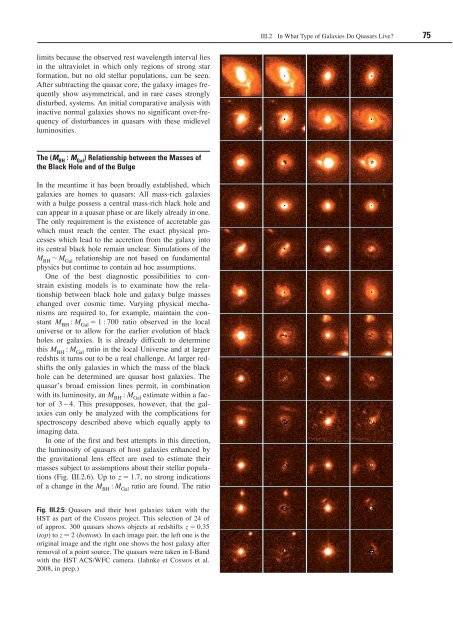Max Planck Institute for Astronomy - Annual Report 2007
Max Planck Institute for Astronomy - Annual Report 2007
Max Planck Institute for Astronomy - Annual Report 2007
Create successful ePaper yourself
Turn your PDF publications into a flip-book with our unique Google optimized e-Paper software.
limits because the observed rest wavelength interval lies<br />
in the ultraviolet in which only regions of strong star<br />
<strong>for</strong>mation, but no old stellar populations, can be seen.<br />
After subtracting the quasar core, the galaxy images frequently<br />
show asymmetrical, and in rare cases strongly<br />
disturbed, systems. An initial comparative analysis with<br />
inactive normal galaxies shows no significant over-frequency<br />
of disturbances in quasars with these midlevel<br />
luminosities.<br />
The (M BH : M Gal ) Relationship between the Masses of<br />
the Black Hole and of the Bulge<br />
In the meantime it has been broadly established, which<br />
galaxies are homes to quasars: All mass-rich galaxies<br />
with a bulge possess a central mass-rich black hole and<br />
can appear in a quasar phase or are likely already in one.<br />
The only requirement is the existence of accretable gas<br />
which must reach the center. The exact physical processes<br />
which lead to the accretion from the galaxy into<br />
its central black hole remain unclear. Simulations of the<br />
M BH M Gal relationship are not based on fundamental<br />
physics but continue to contain ad hoc assumptions.<br />
One of the best diagnostic possibilities to constrain<br />
existing models is to examinate how the relationship<br />
between black hole and galaxy bulge masses<br />
changed over cosmic time. Varying physical mechanisms<br />
are required to, <strong>for</strong> example, maintain the constant<br />
M BH : M Gal 1 : 700 ratio observed in the local<br />
universe or to allow <strong>for</strong> the earlier evolution of black<br />
holes or galaxies. It is already difficult to determine<br />
this M BH : M Gal ratio in the local Universe and at larger<br />
redshts it turns out to be a real challenge. At larger redshifts<br />
the only galaxies in which the mass of the black<br />
hole can be determined are quasar host galaxies. The<br />
quasarʼs broad emission lines permit, in combination<br />
with its luminosity, an M BH : M Gal estimate within a factor<br />
of 3 – 4. This presupposes, however, that the galaxies<br />
can only be analyzed with the complications <strong>for</strong><br />
spectroscopy described above which equally apply to<br />
imaging data.<br />
In one of the first and best attempts in this direction,<br />
the luminosity of quasars of host galaxies enhanced by<br />
the gravitational lens effect are used to estimate their<br />
masses subject to assumptions about their stellar populations<br />
(Fig. III.2.6). Up to z 1.7, no strong indications<br />
of a change in the M BH : M Gal ratio are found. The ratio<br />
Fig. III.2.5: Quasars and their host galaxies taken with the<br />
HST as part of the co S m o S project. This selection of 24 of<br />
of approx. 300 quasars shows objects at redshifts z 0.35<br />
(top) to z 2 (bottom). In each image pair, the left one is the<br />
original image and the right one shows the host galaxy after<br />
removal of a point source. The quasars were taken in I-Band<br />
with the HST ACS/WFC camera. (Jahnke et co S m o S et al.<br />
2008, in prep.)<br />
III.2 In What Type of Galaxies Do Quasars III.X Live? Titel 75

















